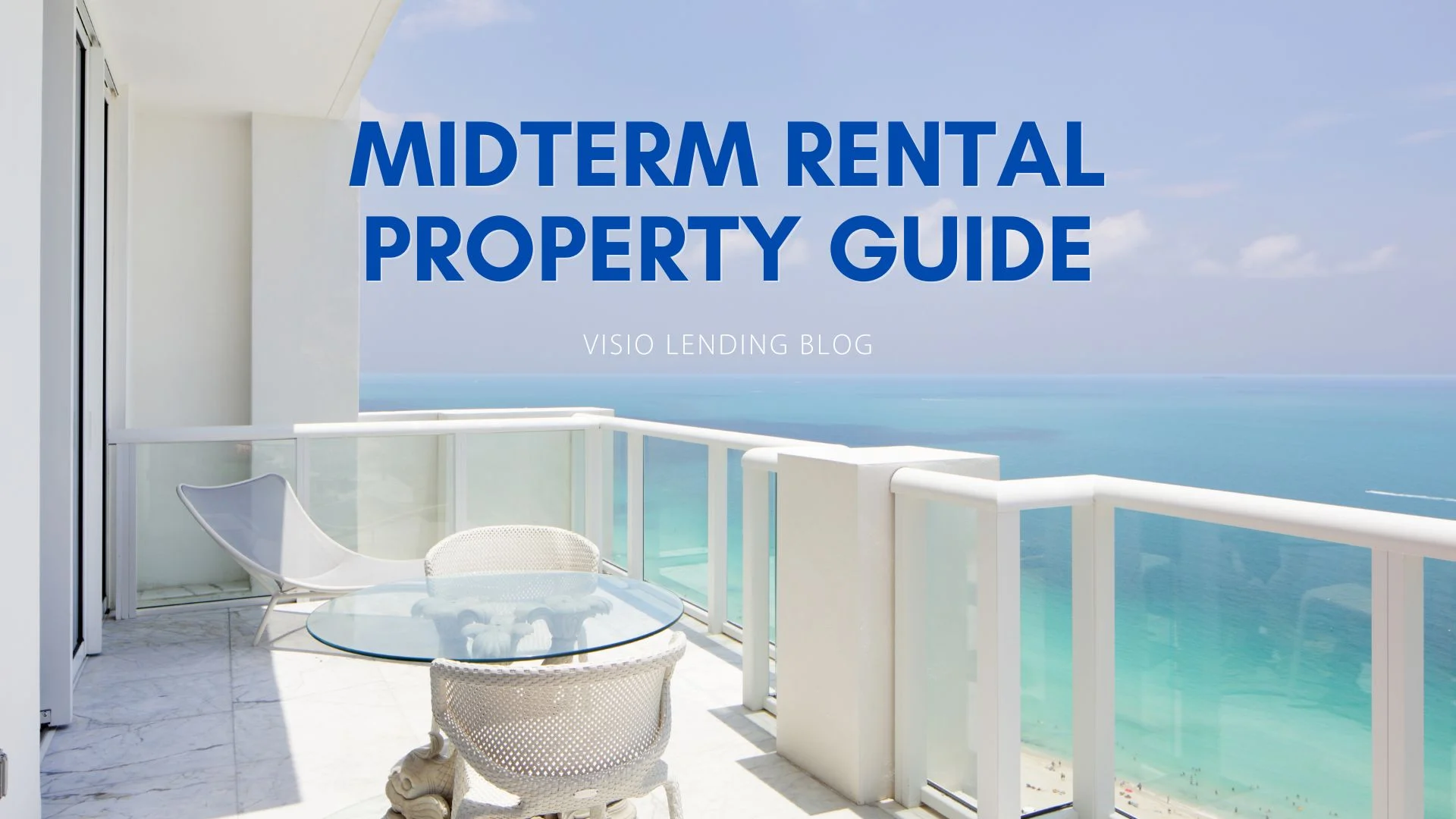When landlords think about boosting their rental income, they often think of two particular rental categories: long-term rentals and short-term rentals. While both offer various advantages, they also have some downsides. Short-term rentals require intensive property management, but they have higher earning potential, and the opposite is true for long-term rentals.
Medium-term rentals offer a third option, offering a variety of advantages over the other term types. Today, we’ll discuss the benefits of mid-term rentals and explain how to get started with this property type.
What Are Mid-Term Rental Properties?
Mid-term rentals are rental agreements that range from a few weeks to a few months. They are month-to-month leases in typically furnished apartments. Just like with long-term housing, mid-term tenants will be paying rent on a monthly basis, but their lease agreement can be negotiated much faster according to market demand, allowing for more dynamic pricing.
Who Leases Out Mid-Term Rentals?
A medium-term rental lease appeals to several classes of renters, who may not be in one place long enough to warrant long-term leases but aren’t willing to deal with the instability of short-term vacation rentals; this includes students, remote workers, and corporations.
Students
College students are especially common consumers of mid-term leases because the typical college year is only about nine months long.
Many prefer not to live in dorms due to the cramped environment, and they may not want to stay in their new city over summer vacation if they are far from their hometown, which makes a long-term lease economically disadvantageous.
As a lot of mid-term housing offers fully furnished apartments, this helps college students save on houseware that they won’t have a need for once they return home.
Traveling Workers
With the rise of remote work has come a new class of renters — digital nomads who want to experience another city or country while still earning money.
Month-to-month rentals appeal to these workers because if they choose a short-term rental, they might need to pack up and move in a week, reducing the time they have to relax on the weekend. At the same time, these shorter lease agreements give them the flexibility to head to a new city or back to their permanent home when they choose.
These prospective tenants will also appreciate furnished properties because then they won’t need to send heavy furniture like desks to their next accommodation.
Companies
Many mid-term rentals cater specifically to corporate housing needs, such as for travel nurses and business travelers.
These workers may be stationed in a certain area for a period of months for a project, and as it’s usually infeasible to book one hotel room for months at a time, their companies may prefer to arrange monthly housing rentals instead.
This can also be more attractive for families relocating due to a job opportunity because it affords a sense of stability.
Mid-Term Rentals vs. Short-Term Rentals
When property owners consider housing leases of less than a year, they may immediately think of short-term housing of less than a month, but this option has some risks.
The higher tenant turnover requires property managers to ensure that the property is immediately ready for new tenants. As vacation spots have off-peak seasons, seasonal fluctuations in demand may imperil cash flow.
Additionally, local regulations may discourage a property owner from managing short-term rentals. For example, many popular vacation destinations like San Francisco have been cracking down on Airbnbs for fear that they are making it more difficult for new renters to get year-long leases on good properties.
Catering to mid-term stays eliminates many of these problems, providing a happy medium between short-term accommodations and long-term rentals. Mid-term rentals provide more consistent income with less property management, and they are not as prone to regulatory overreach as short-term options.
Mid-Term Rentals vs. Long-Term Rentals
Long-term rentals have long been the standard when it comes to renting, but they don’t appeal to tenants who need more flexibility. Both require a certain level of upkeep, such as providing laundry facilities and managing maintenance requests, but there is less risk of property damage with mid-term renters because they will not be spending years in a property.
The type of property you use depends on your rental market. In college towns, a medium-term rental will be an attractive option for potential tenants, while those in smaller towns may be seeking a long-term commitment.
Buildings near large companies or hospitals may create corporate housing needs that are perfect for mid-term rentals. Research the mid-term rental market in your area to understand which option may be best suited for your particular property.
Benefits of Mid-Term Rentals
Medium-term rentals offer a variety of benefits over short-term housing or a yearly lease agreement, making them a great choice for property owners in specific areas. Some of their main points include the following.
Less Turnover
A short-term rental may have multiple tenants in a week depending on booking, which can be a very labor-intensive process for a property owner.
Not only will you need to clean the property between each booking and check for damage, but you will also need to communicate with renters, manage a complicated schedule, and market the property on various platforms such as Airbnb.
A mid-term rental does not have that problem, as your tenants will be staying for at least a month, reducing the expenditure on marketing and logistics.
Consistent Higher Monthly Income
When managing short-term housing, you will often make a generous profit per night, but the rental income can be sporadic depending on seasonal demand. While you earn less per night with mid-term housing, you are also guaranteed income for at least a month because the unit will be occupied.
Additionally, digital nomads and students are willing to pay a bit more for a fully furnished mid-term rental because the convenience of month-to-month leases warrants the price. You will generally have less of a concern with late payments with remote workers than you might with long-term tenants.
Less Maintenance and Upkeep Costs
Vacation properties necessitate full-time property managers in order to clean between bookings, something that’s not as much of a problem with a mid-term option. At the very most, you will need to clean the property once a month, which helps you keep more of your profits while also reducing the difficulties associated with coordinating check-in times.
A mid-term renter will also not be so hard on a property as a long-term tenant because they are not staying as long, so you are less likely to have to deal with major property issues during their stay. Just as with other rental types, you can charge a security deposit and retain it if there are issues with the tenant.
Entering The Mid-Term Rental Market
Entering the mid-term rental business has many of the same steps as with any other rental option, though there are some things that are slightly different. Consider these major components when you begin your career in mid-term rentals.
Choose a Type of Mid-Term Rental Property
First, you’ll need to think about what type of mid-term rentals you would like to buy, including what market they are in and what demographic they would appeal to. For example, if you are near a major college, you’ll likely be accommodating students, so you will need to think about walkability to campus and local amenities.
Digital travelers will likely want somewhere that is quiet but near things like grocery stores or shops, while those traveling for business want a shorter commute. Considering your target audience and their needs can guide your property search.
Check Local Rules and Regulations
You’ll have to assess the local landlord-tenant laws to understand your rights and obligations toward a tenant, such as the eviction process if a tenant overstays their welcome. Some municipalities have restrictions on the length of lease agreements, which may make it difficult to operate mid-term rentals.
Be sure that you understand what challenges you may face in terms of regulations, seeking the advice of other professionals like lawyers and real estate agents who are familiar with the area.
Find a Suitable Lender
You should select a lender with experience in mid-term rentals, such as Visio Lending. We offer loans designed for investing in real estate, including mid-term rentals.
Our process is based on the Debt Service Coverage Ratio, which identifies your business’s profit margins to determine its creditworthiness. You can also borrow under a business entity, protecting your personal finances from any legal entanglements.
Contact us today to learn more about our loan process and submit a deal for mid-term rentals in your area.
Buy and List the Property
Once you have your chosen property and financing, it’s time to buy. The purchase process is much like what you would expect for a primary residence, including negotiating with the seller, signing paperwork, and providing a down payment.
Next, you’ll need to prepare the property for mid-term rentals. Most properties in this category are furnished, so you’ll purchase affordable furniture, provide cookware and dishes, and put up some light decorations to make it feel like a home.
You’ll then list the property on different listing services, screen tenants, and sign a lease agreement with the tenant, as you would with long-term leases.
Where to List a Mid-Term Rental Property
Mid-term rentals can be listed in the same places as short-term and long-term rentals, including Airbnb, VRBO, Zillow, Trulia, Apartment Guide, and RentCafe. You may also list them on places like Facebook Marketplace or Craigslist.
When you list, specify the minimum length of stay and the type of lease that the individual will be signing, and ensure that the tenant understands your expectations in terms of leases.
Types of Loans for Mid-Term Rental Properties
Most individuals who choose mid-term rentals opt for rental loans, which are made for long-term tenancy. These loans are predicated on the profitability of the venture rather than your personal creditworthiness, meaning that the underwriting process is much simpler than it would be with a conventional loan.
Instead of investigating your tax returns, lenders will identify the potential income of the property and divide it by its debt service: the mortgage, insurance, taxes, and association dues. This creates the Debt Service Coverage Ratio (DSCR), which most lenders expect to be 1.2 or above.
Visio Lending is one of the top DSCR lenders in the country thanks to our streamlined process and sensible underwriting. Property owners can roll multiple buildings into the same loan, which simplifies financing and makes it easier to expand their portfolio faster.
What is the ROI on mid-term rentals?
Mid-term housing often has a higher ROI than long-term properties thanks to the higher premiums. Whereas a good cash-on-cash return for a typical rental is about 10%, you can enjoy as much as a 15% cash-on-cash return for a mid-term investment.
How many months is considered mid-term for rentals?
A mid-term is defined as anything above one month but less than 12 months. The lease is typically renewed on a monthly basis rather than a weekly or yearly basis.
What does MTR mean in real estate?
MTR stands for medium-term rentals, or properties that are rented out for more than a month but less than a year at a time. These rentals have the advantage of higher monthly income than long-term rentals but with less property management than vacation rentals.
Can I get a loan for a mid-term rental property that needs renovations?
Yes, but these are typically hard money loans rather than long-term loans like Visio Lending. These loans can be used to pay for the property and any renovations it requires, but they have very short terms, usually less than two years, and very high interest rates. They are good for short-term needs like renovations but can be difficult to pay back due to their rates.
Thankfully, it is possible to refinance them into something more stable. After you have completed the renovations, you can refinance your hard money loan into a 30-year fixed-rate term that will provide you with more affordable payments.






